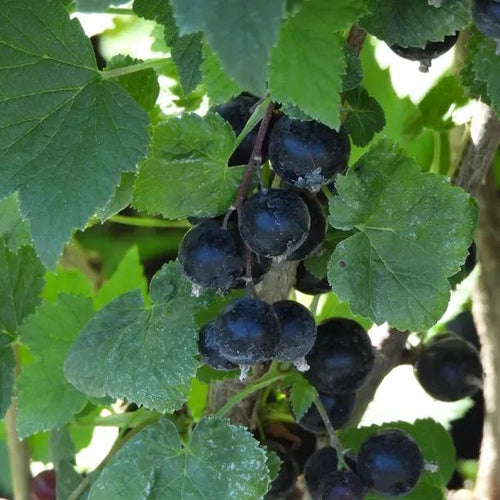'Ben Lomond' Blackcurrant Bushes
Ben Lomond Blackcurrants are longstanding favourite of amateur fruit growers. It's ideal for small gardens and pots; compact with strong, upright growth, reaching a maximum height and spread of just 1.5m while still bearing a heavy late crop. There are bigger varieties and ones that crop earlier in our range of currant bushes.
Ben Lomond is one parent of Ben Connan, which is more disease resistant plant, so we recommend Connan for damper or darker areas that are prone to mildew.
Ben Lomond will give you a reliable crop of high quality, very large clusters of fruit on short strings for easy picking. The intense flavour is excellent, a balance of sharp and sweet. The currants freeze well and are ideal for eating raw or cooking.
Blackcurrants are at their best about a week after they have turned black. Pick them individually or, to keep them fresh for longer, harvest the whole string. Pick in dry conditions, and they'll stay fresh in the fridge for up to two weeks. Freeze as soon as possible after picking, and they'll keep for at least six months.
Blackcurrants are real superfoods, packed with antioxidants, anthocyanins, polyphenols, Vitamin C and minerals. Research suggests that the dark berries may help to reduce the symptoms of neurological illness and reduce the risk of some cancers.
Grow your own currants
One of the best features of Ben Lomond is its resistance to cold - in fact, bushes actually need a spell of cold weather to perform at their best. It's late flowering, so its blooms are frost resistant in almost all but the most extreme conditions and it fruits in late July-August.
Choose a sunny, sheltered spot out of strong winds with well-drained soil (or compost in a container). Plant 1.5m apart if growing bushes in a traditional stand-alone row, with 2m between rows. However, you can plant several closer together to make an attractive and productive hedge.
Blackcurrant Ben Lomond is self-fertile, so you only need one. Feed with blood, fish and bone in April, followed by a high nitrogen plant food in June. Keep the ground clear of weeds to avoid competition.
In some cooler, damper or shadier conditions, mildew can be an annoyance: to prevent it, prune plants yearly, and keep centre of the bush open for air circulation.
Features
- Fruit: Large clusters of glossy black berries
- Taste: Intense sweet and sharp balance
- Use: Cooking or raw, freezes well
- Picking: July to August
- Height: 1m to 1.5m
- Spread: 1m to 1.5m
- Spacing: 1.5m apart
- Self-fertile variety
- Late flowering variety with frost-resistant flowers
History & Trivia
Ben Lomond was the first Ben blackcurrant developed in the celebrated 'Ben' series by the SCRI, Scottish Crop Research Institute, in 1975. Today, the SCRI is called The James Hutton Institute, after a merger with The Macaulay Land Use Research Institute.

 Secure, One-Tap Checkout
Secure, One-Tap Checkout
 Hand Picked, Delivered to Your Door!
Hand Picked, Delivered to Your Door! 1 Year Bareroot Guarantee
1 Year Bareroot Guarantee


